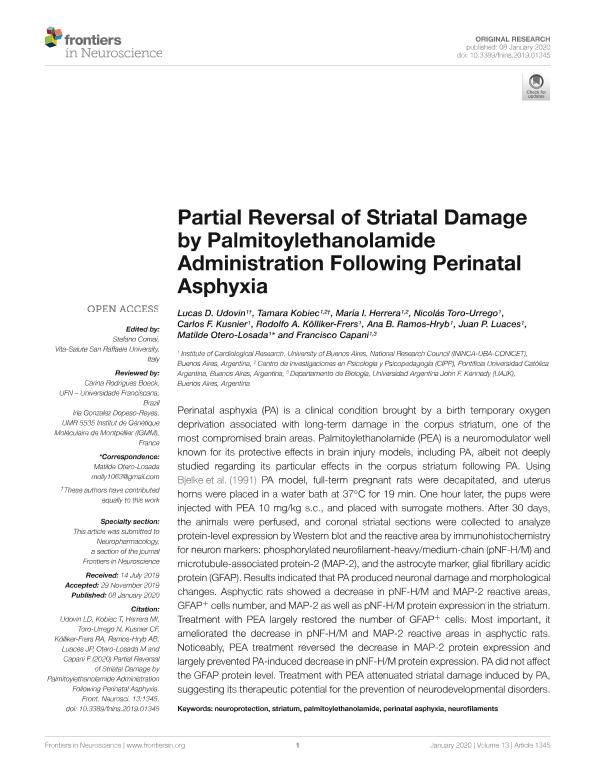Artículo
Partial Reversal of Striatal Damage by Palmitoylethanolamide Administration Following Perinatal Asphyxia
Udovin, Lucas ; Kobiec, Tamara
; Kobiec, Tamara ; Herrera, María Inés
; Herrera, María Inés ; Toro Urrego, Nicolas
; Toro Urrego, Nicolas ; Kusnier, Carlos Federico
; Kusnier, Carlos Federico ; Kolliker Frers, Rodolfo Alberto
; Kolliker Frers, Rodolfo Alberto ; Ramos Hryb, Ana Belen
; Ramos Hryb, Ana Belen ; Luaces, Juan Pablo
; Luaces, Juan Pablo ; Otero-losada, Matilde Estela
; Otero-losada, Matilde Estela ; Capani, Francisco
; Capani, Francisco
 ; Kobiec, Tamara
; Kobiec, Tamara ; Herrera, María Inés
; Herrera, María Inés ; Toro Urrego, Nicolas
; Toro Urrego, Nicolas ; Kusnier, Carlos Federico
; Kusnier, Carlos Federico ; Kolliker Frers, Rodolfo Alberto
; Kolliker Frers, Rodolfo Alberto ; Ramos Hryb, Ana Belen
; Ramos Hryb, Ana Belen ; Luaces, Juan Pablo
; Luaces, Juan Pablo ; Otero-losada, Matilde Estela
; Otero-losada, Matilde Estela ; Capani, Francisco
; Capani, Francisco
Fecha de publicación:
01/2020
Editorial:
Frontiers Media S.A.
Revista:
Frontiers in Neuroscience
ISSN:
1662-4548
e-ISSN:
1662-453X
Idioma:
Inglés
Tipo de recurso:
Artículo publicado
Clasificación temática:
Resumen
Perinatal asphyxia (PA) is a clinical condition brought by a birth temporary oxygen deprivation associated with long-term damage in the corpus striatum, one of the most compromised brain areas. Palmitoylethanolamide (PEA) is a neuromodulator well known for its protective effects in brain injury models, including PA, albeit not deeply studied regarding its particular effects in the corpus striatum following PA. Using Bjelke et al. (1991) PA model, full-term pregnant rats were decapitated, and uterus horns were placed in a water bath at 37°C for 19 min. One hour later, the pups were injected with PEA 10 mg/kg s.c., and placed with surrogate mothers. After 30 days, the animals were perfused, and coronal striatal sections were collected to analyze protein-level expression by Western blot and the reactive area by immunohistochemistry for neuron markers: phosphorylated neurofilament-heavy/medium-chain (pNF-H/M) and microtubule-associated protein-2 (MAP-2), and the astrocyte marker, glial fibrillary acidic protein (GFAP). Results indicated that PA produced neuronal damage and morphological changes. Asphyctic rats showed a decrease in pNF-H/M and MAP-2 reactive areas, GFAP+ cells number, and MAP-2 as well as pNF-H/M protein expression in the striatum. Treatment with PEA largely restored the number of GFAP+ cells. Most important, it ameliorated the decrease in pNF-H/M and MAP-2 reactive areas in asphyctic rats. Noticeably, PEA treatment reversed the decrease in MAP-2 protein expression and largely prevented PA-induced decrease in pNF-H/M protein expression. PA did not affect the GFAP protein level. Treatment with PEA attenuated striatal damage induced by PA, suggesting its therapeutic potential for the prevention of neurodevelopmental disorders.
Archivos asociados
Licencia
Identificadores
Colecciones
Articulos(ININCA)
Articulos de INST.DE INVEST.CARDIOLOGICAS (I)
Articulos de INST.DE INVEST.CARDIOLOGICAS (I)
Articulos(SEDE CENTRAL)
Articulos de SEDE CENTRAL
Articulos de SEDE CENTRAL
Citación
Udovin, Lucas; Kobiec, Tamara; Herrera, María Inés; Toro Urrego, Nicolas; Kusnier, Carlos Federico; et al.; Partial Reversal of Striatal Damage by Palmitoylethanolamide Administration Following Perinatal Asphyxia; Frontiers Media S.A.; Frontiers in Neuroscience; 13; 1-2020; 1-10
Compartir
Altmétricas



